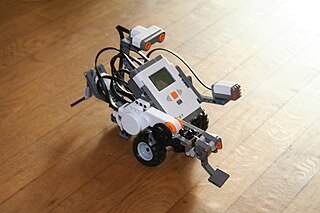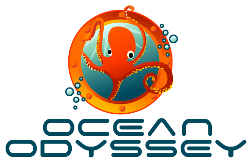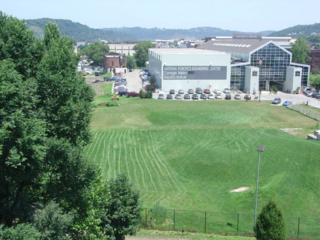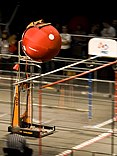
Lego Mindstorms is a discontinued hardware and software structure which develops programmable robots based on Lego bricks.

A try is a way of scoring points in rugby union and rugby league football. A try is scored by grounding the ball in the opposition's in-goal area. Rugby union and league differ slightly in defining "grounding the ball" and the "in-goal" area. In rugby union a try is worth 5 points, in rugby league a try is worth 4 points.

Roomba is a series of autonomous robotic vacuum cleaners made by the company iRobot, introduced in September 2002. The vacuums have a set of sensors used to help them navigate the floor area of a home. These sensors can detect the presence of obstacles and steep drops.

The FIRST LEGO League Challenge is an international competition organized by FIRST for elementary and middle school students.

Lego Mindstorms NXT is a programmable robotics kit released by Lego on August 2, 2006. It replaced the Robotics Invention System, the first-generation Lego Mindstorms kit. The base kit ships in two versions: the retail version and the education base set. It comes with the NXT-G programming software or the optional LabVIEW for Lego Mindstorms. A variety of unofficial languages exist, such as NXC, NBC, leJOS NXJ, and RobotC. A second-generation set, Lego Mindstorms NXT 2.0, was released on August 1, 2009, with a color sensor and other upgrades. The third-generation EV3 was released in September 2013.

FIRST Tech Challenge (FTC), formerly known as FIRST Vex Challenge, is a robotics competition for students in grades 7–12 to compete head to head, by designing, building, and programming a robot to compete in an alliance format against other teams. FIRST Tech Challenge is one of the five major robotics programs organized by FIRST, which its other four programs include FIRST Lego League Discover, FIRST Lego League Explore, FIRST Lego League Challenge, and FIRST Robotics Competition.

Nano Quest was the name of the 2006–07 challenge theme of FIRST Lego League. It revolved around the emerging field of nanotechnology.

Botball is an educational robotics program that focuses on engaging middle and high school aged students in team-oriented robotics competitions. Thousands of children and young adults participate in the Botball program. It has been active since 1998 and features a robotics curriculum which focuses on designing, building and programming a pair of autonomous robots. Teams use a standardized kit of materials, document the process and then compete in a tournament in which the challenges change annually. All materials in the kits are exactly the same for every team around the world, so there are no unfair advantages. Botball teams are mostly based in the United States with over 300 teams and local tournaments in more than a dozen regions. In recent years it also holds an annual Global Conference on Educational Robotics (GCER), with an international tournament that attracts teams all over the country as well as from Mexico, Austria, China, Uganda, Poland, Qatar, Kuwait, Egypt, and many others.

FIRST LEGO League Explore (FLLE) is a non-competitive robotics program designed for children ages six to ten. It is one of the programs established by FIRST.

Half-Pipe Hustle was the first official FIRST Vex Challenge (FVC) game, taking place in 2005–2006. In this challenge, robotics teams built robots from the Vex design kit to compete in competitions across the United States and in other nations, in matches consisting of a 45-second autonomous period, followed by a 2-minute driver control period in which the robots are controlled by team drivers using remote controls.
The World Robot Olympiad (WRO) is a global robotics competition for young people. The World Robot Olympiad competition uses Lego Mindstorms manufactured by LEGO Education. First held in 2004 in Singapore, it now attracts more than 28,000 teams from more than 85 countries.
Mission Mars was the 2003-04 challenge theme of FIRST Lego League. It revolved around the NASA missions to Mars with the Spirit and Opportunity rovers.

Food Factor is the FIRST Lego League (FLL) competition for 2011-12; released on September 2. It focuses on food safety and methods to prevent contamination.

Body Forward is the 2010-11 FIRST Lego League competition. The project and missions revolve around biomedical engineering.
Climate Connections was the 2008-09 FIRST Lego League competition. Its theme centered on understanding the effects of climate and climate change.

Ocean Odyssey is the 2005-06 FIRST Lego League challenge theme. It centered on topics relating to the world's oceans and oceanography. The challenge was developed with the collaboration of the Woods Hole Oceanographic Institution and the Monterey Bay Aquarium Research Institute.

No Limits is the 2004-05 FIRST Lego League challenge theme. It focused on solutions for aiding people with physical disabilities. The year's theme was introduced by the story Late for Lunch by James Patrick Kelly, which the described the life of a disabled child.

The National Robotics Engineering Center (NREC) is an operating unit within the Robotics Institute (RI) of Carnegie Mellon University. NREC works closely with government and industry clients to apply robotic technologies to real-world processes and products, including unmanned vehicle and platform design, autonomy, sensing and image processing, machine learning, manipulation, and human–robot interaction.

FIRST Steamworks, stylized as FIRST STEAMworks, was the FIRST Robotics Competition game for the 2017 season. As in past games, two alliances of three individual teams and their robots compete on a field to score "match" point to win the game and ranking points to advance to playoff rounds. The game has a steampunk theme and teams are required to shoot wiffle balls which represent fuel into a simulated boiler which transfers the generated steam into an airship in the middle of the field. Each alliance has one airship, which they pressurize with steam from the boiler and load with plastic gears from the field. At the end of the match, robots can climb and hang on team-supplied ropes attached to the airship for additional points.

Rover Ruckus, officially known as Rover Ruckus Presented by Qualcomm for sponsorship reasons, is the FIRST Tech Challenge game for the 2018–2019 season. In the competition, two alliances of two teams each compete to collect minerals and place them into the cargo holes of the lander. Rover Ruckus is the fourteenth FTC game.


















